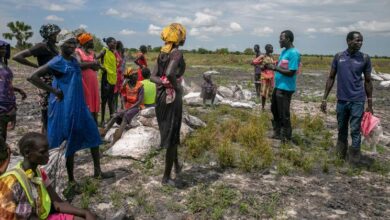False claims about the origin of Hurricane Milton spread online
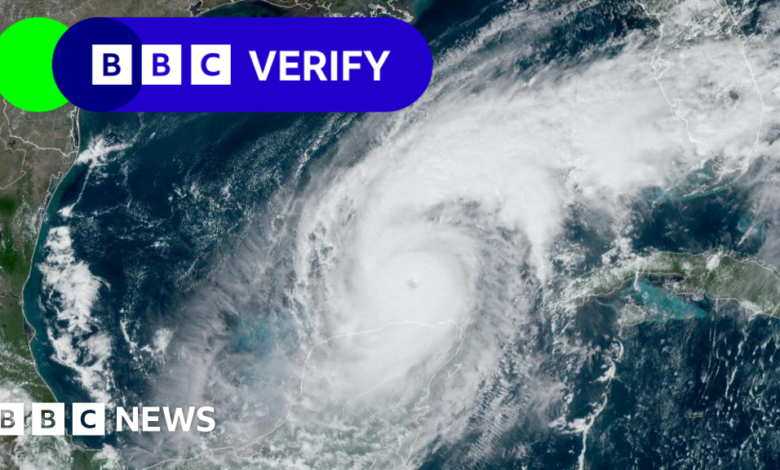
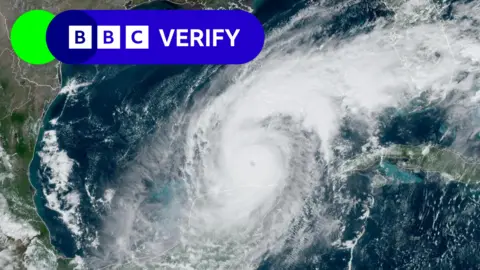 Reuters/NOAA
Reuters/NOAAFalse claims that Hurricane Milton was “orchestrated” and that the weather in Florida is being “manipulated” have spread on social media.
There is no technology that allows humans to create and control storms.
But on platforms like X and TikTok, posts alleging – without evidence – that the US government is secretly controlling the weather have been viewed millions of times.
Many were posted by accounts known for spreading conspiracy theories, as well as misinformation about Covid-19 or vaccines.
These users share the belief that Hurricane Milton, one of the most powerful storms in recent U.S. history, was intentionally created by dark forces at the heart of American politics.
But they have proposed a number of different explanations for how to do that.
Some users claim that weather manipulation techniques such as cloud seeding are to blame.
Cloud seeding involves manipulating existing clouds to try to create more rain, for example in countries with dry climates.
But the southeastern United States was hit with heavy rainfall from Hurricane Helene, which caused deadly flooding in several states just two weeks ago.
“When we do cloud seeding, it’s because we don’t have enough aerosols or water vapor in the atmosphere to see a condensation,” said Jill Trepanier, an expert on severe weather events in Louisiana. Condensation happens, so we try to force it through cloud seeding.” University.
“In the western Gulf of Mexico and the Gulf of Campeche, that’s not a problem. The Earth will create a storm of its own.”
Other users instead blame “geoengineering” – a series of methods aimed at manipulating the environment to reduce the impact of climate change.
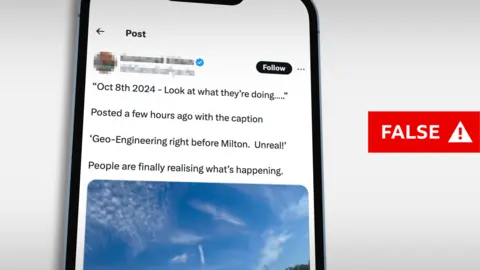
But there are no tools that allow humans to create or control storms like this.
“There is no possibility of using current knowledge and technology to use geoengineering to modify storms,” said Suzana Camargo from the Lamont-Doherty Earth Observatory at Columbia University.
Storms are natural weather systems.
Typically, they begin as what are called tropical waves – low pressure areas where thunderstorms and clouds develop.
As strong winds pushed the system out of Africa and toward the Americas, warm, moist air rose from the tropical Atlantic, and the system of clouds and winds began to spin.
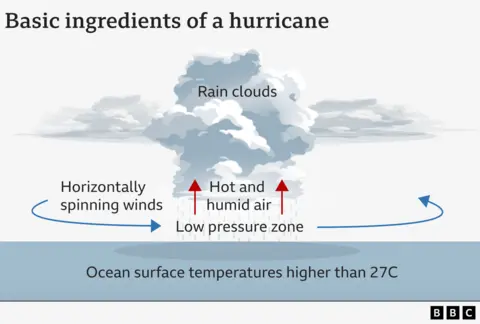
With enough energy from warm ocean water, combined with favorable circulation patterns in the atmosphere, it can strengthen into a hurricane.
Social media posts seen by BBC Verify falsely suggest that storms like these are being created for sinister reasons, including an attempt to influence next month’s presidential election .
Those claims are false, but there is a link to human activity due to climate change that is making these storms generally more intense.
Climate change – caused by emissions of planet-warming gases such as carbon dioxide from human activities – is not thought to be increasing the number of tropical cyclones worldwide.
But rising temperatures make the strongest storms more likely.
Warmer ocean waters mean these storms can gain more energy, potentially leading to higher wind speeds.
Storm Milton strengthened particularly rapidly as it moved through the Gulf of Mexico, where sea surface temperatures were about 1-2C warmer than average.
The highest sustained wind speed increases from 90 mph (150km/h) ARRIVE 175 mph (280 km/h) in just 12 hours on October 7, according to National Hurricane Center data.
For some social media users, this sudden change was seen as “evidence” supporting their view that this was not a “natural” storm but man-made.
But the trend is consistent with predictions that storms tend to strengthen faster in a warming world.
“As we warm the planet, we anticipate a lot of potential impacts on hurricanes that could make them more dangerous,” explains Andra Garner, an assistant professor at Rowan University in New Jersey. more dangerous – including the ability to strengthen more rapidly in unusually warm ocean waters.” .
Hurricane Helene – which made landfall in Florida about two weeks ago – also rapidly strengthened over the Gulf of Mexico.
A new study published Wednesday shows that exceptionally high sea surface temperatures in its path are hundreds of times more likely to be caused by human-caused warming.
“[Helene] It is significantly more destructive due to climate change, explains Ben Clarke of the World Weather Record Group, who led the study.
In addition to generally stronger winds, climate change is also affecting other storm hazards.
Warmer atmosphere can hold more moisture – up to about 7% for every 1C increase in temperature. This means rainfall could be more intense.
And global sea levels have been rising in recent decades, largely due to global warming. This makes it more likely that a given storm surge – a short-term rise in sea level due to a storm – will lead to coastal flooding.
In Florida, the average sea level has increased by more than 18cm (7in) since 1970according to US government data.
To some users spreading conspiracy theories surrounding Hurricane Milton, this also amounts to “scaremongering”. But the evidence shows the opposite.



